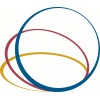
A Study Assessing the Efficacy and Safety of DE-127 Ophthalmic Solution in Subjects With Mild or...
MyopiaTo investigate the safety and efficacy of three concentrations of DE-127 ophthalmic solution when compared to Placebo in subjects diagnosed with mild or moderate myopia. To investigate the dose response of DE-127.

Intravitreal Conbercept Injection in Patients With Myopic Choroidal Neovascularization
Myopic Choroidal NeovascularisationChoroidal neovascularization (CNV) secondary to pathologic myopia (PM-CNV) is a common vision-threatening complication and often affects adults of working age. Intravitreal injection of any anti-vascular endothelial growth factor (VEGF) drugs would significantly suppress the activity of the CNV and finally improve the visual acuity. However, more than half of the patients would need one or more further injection for the recurrence or uncontrolled with 1+pro re nata (PRN) treatment within one year, and whether increasing the initial loading of intravitreal injection of anti-VEGF would be more efficacy for the controlling the PM-CNV remained unknown.

Preservative-free Topical Anesthetics for Post-PRK Pain
MyopiaThe goal of this interventional comparative study is to assess the efficacy and safety of a novel regimen of preservative-free unit-dose topical anesthetics for controlling early postoperative pain following single-step transepithelial PRK surgery. The main research questions to answer are: Question 1: Are topical anesthetics effective in reducing post-PRK pain? Question 2: Are short-term topical anesthetics toxic to the cornea? Question 3: How to prevent abuse of topical anesthetics by patients at home? Participants were planned to undergo a bilateral single-step transepithelial PRK surgery to correct their refractive errors and received a standard post-PRK treatment regimen for both eyes. Additionally, one eye was offered a preservative-free topical anesthetic as an experimental group and the other eye was offered a preservative-free artificial tear as a control group.

Dynamic Change in Accommodation After Wearing Multifocal Soft Contact Lenses for Myopia Control...
MyopiaAccommodationThe purpose of this study is to report the changes in accommodation, aberrations, and myopia in patients wearing multifocal soft contact lens for various durations. The study objectives are to: Determine the effects of wearing multifocal soft contact lens on accommodation and aberrations over a 12-month period. Determine the effect of wearing multifocal soft contact lens on myopia over a 12-month period.
Myopia Control With Orthokeratology Contact Lenses in Spain
MyopiaProgressive6 moreThe purpose of this prospective study is to assess the efficacy, safety and patient-reported outcomes of the Menicon Z Night orthokeratolgy contact lens for reducing myopia progression in children.

Clinical Evaluation on Using Personal Face Masks With Spectacles Versus Contact Lenses
MyopiaThe aim of this study was to explore satisfaction with vision correction and ease of use of PFM (Personal Face Masks) in a group of spectacle wearers who were randomised to continue wearing spectacles or be fitted with daily disposable contact lenses.

Phase 1 Study of SHJ002 Sterile Ophthalmic Solution in Pediatric Subjects
MyopiaThis is a single-center, open-label, first-in-human dose-escalation study of SHJ002 Ophthalmic Solution in children. (Part 1) Three (3) subjects will receive each concentration of SHJ002 for 3 days in an escalation design in one eye. (Part 2) A Group of 9 additional children will receive the highest tolerated concentration for 28 days.

Macular Buckle With Three-armed Silicone
High MyopiaPosterior StaphylomaHigh myopia is characterized by prolonged axial length and posterior staphyloma, which result in choroid-retinal degeneration and vision decrease. At present, vitrectomy can lead to anatomical improvements, but an higher axial length and the presence of a sever posterior staphyloma remains to be the two most important risk factors for poor visual outcomes. For these reasons, a different surgical approach, including macular buckling, might be considered in those patients with extremely high degree of myopia, in order to counteract the traction exerted by the posterior staphyloma. Macular buckling with or without pars plana vitrectomy had been proved to be an effective way to resolve myopic staphyloma related foveoschisis, macular hole, and associated retinal detachment. In this study, we sought to investigate the safety and efficacy of a macular buckling technique using a three-armed silicone capsule to support the posterior staphyloma in high myopia.

Initial Treatment With Bevacizumab in Choroidal Neovascularization Associated to High Myopia
Choroidal Subfoveal/Juxtafoveal Neovascularization in High MyopiaThe purpose of this protocol is to determine wether the initial protocol in the treatment of subfoveal choroidal neovascularization associated to High Myopia with bevacizumab intravitreal injections is more effective when using 3 doses vs using 1 single dose in the load period

A Safety and Effectiveness Study of PRK Using the ALLEGRETTO WAVE® EYE-Q Excimer Laser System
MyopiaAstigmatismThe purpose of this study is to evaluate the safety and effectiveness of the ALLEGRETTO WAVE EYE-Q excimer laser system for the reduction of myopia with or without astigmatism in subjects undergoing photorefractive keratectomy (PRK) treatment.
